 
|
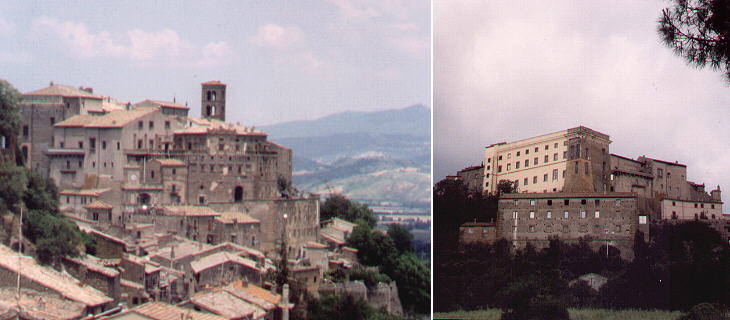 | ||
Old Bomarzo is situated between two palaces belonging to the Orsini: the first one, at the entrance of the town has some medieval features, while the second one has a distinctive Renaissance design.
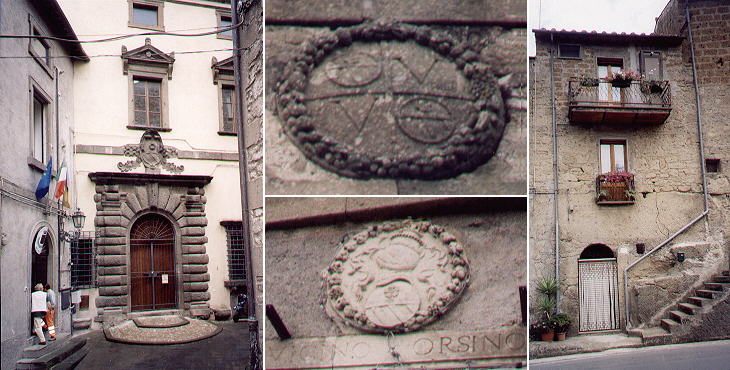 | ||
Coats of arms of the Orsini combined with monograms of Vicino Orsini decorate the external walls and the streets of Bomarzo. For sure the inhabitants of Bomarzo gained from all this building activity of their lord, but their living conditions were nonetheless very miserable.
XVIIIth century travellers who crossed the border between the Granduchy of Tuscany and the Papal State were struck by seeing the inhabitants of villages and small towns living in caves.
The house shown above has retained a ground floor dug into the rock: the two floors above the door are a relatively recent addition so originally the house consisted of just a single room getting light from the door.
In some cases tombs, which the Etruscans had cut in the rock, were turned into houses. The towns of Grotte (caves) di Castro and Grotte di S. Stefano retain in their names a description of their former appearance.
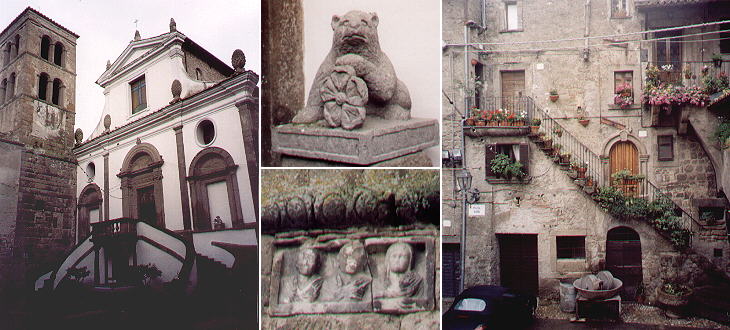 | ||
Vicino Orsini took care of the only church of old Bomarzo, which was given an elegant Renaissance fašade (the steps are a later addition). The old bell tower is decorated with a Roman funerary relief, while the church has a couple of bears holding a rose: the rose is an element of the Orsini's coat of arms, while the bear (orso in Italian) is a traditional reference to the Orsini.
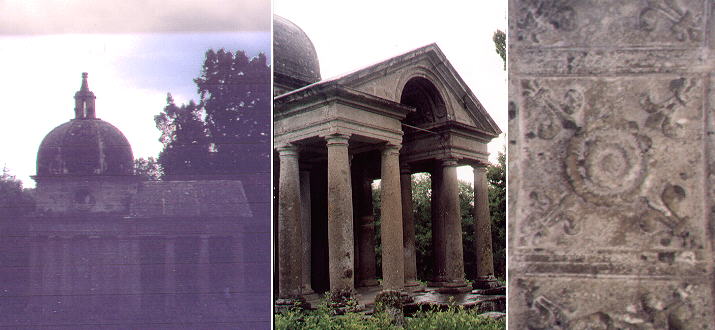 | ||
Giulia Farnese passed away in 1564 and her husband dedicated to her an intriguing garden in the valley below Bomarzo. Giulia was a daughter of Galeazzo Farnese, duke of Latera, a relative of Pope Paulus III. She must not be confused with another Giulia Farnese, elder sister of the pope, who made use of her beauty with Pope Alexander VI to promote the career of her brother: she was so successful that he was appointed cardinal at the age of 26.
At the entrance of the garden Vicino Orsini built a sort of temple, which is a mix of classical and Renaissance elements. The ceiling of the porch is decorated with the rose of the Orsini and the lilies of the Farnese.
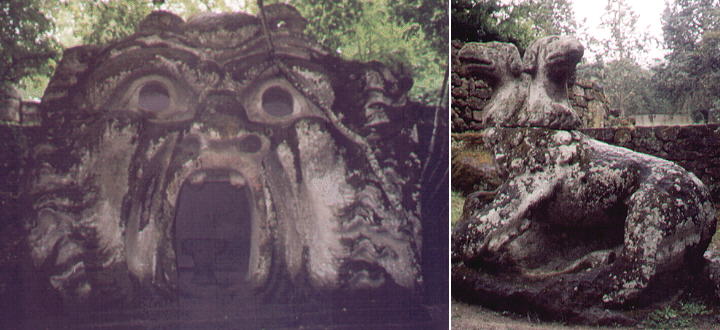 | ||
The garden is today known as Parco dei Mostri, but this is a modern name and as a matter of fact many other late Renaissance gardens have sculptures portraying mythological animals or gigantic faces. But the Orsini garden was abandoned for centuries and its sculptures covered by vegetation and almost forgotten, so when the current owners of the garden started a lengthy restoration to bring it back to its former splendour, the sculptures were labelled as monsters and the name helped in "marketing" the garden.
The gigantic mask was a picnic spot as the mouth has room for seats and a small table.
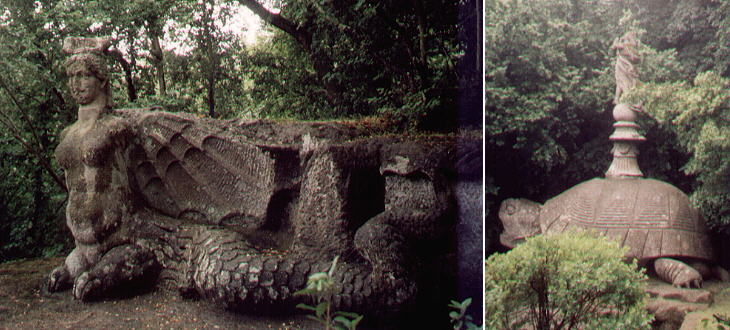 | ||
The mermaid shown above had a practical purpose too: her long tail could be used as a bench. What makes Bomarzo so different from other Renaissance gardens is its lack of symmetry. A relatively small area is crammed with gigantic statues which can be fully seen close-up: the shield of the tortoise comes into view a certain distance away and appears to be the dome of a small temple: only at a few yards from it one discovers the rest of the body.
Without doubt Vicino Orsini wanted to surprise his guests: probably he realized his garden could not compete in size and richness with those of other more powerful Italian families and he chose to enhance its originality.
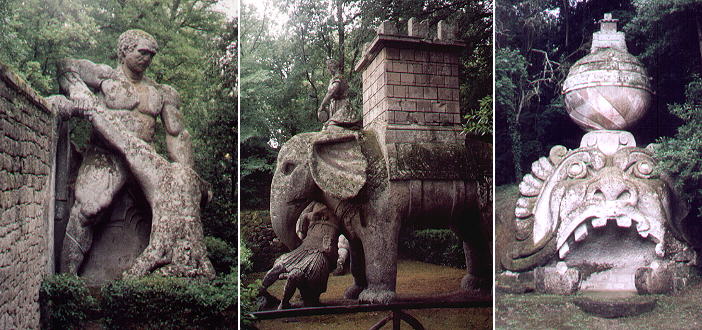 | ||
Unlike other gardens which were continuously visited through the centuries and of which we know the meaning of fountains and sculptures, for most of the statues of this garden we do not have a convincing explanation of how the subjects were selected and assembled. For sure the combat elephant is a reference to either Hannibal or Pyrrhus who both made use of them to disrupt the Roman legions: but how this is linked to the life and actions of Vicino Orsini we do not know.
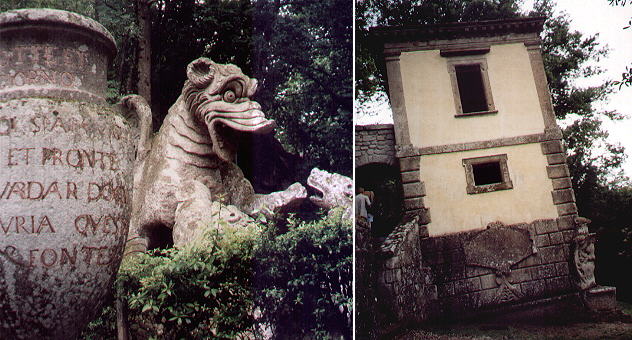 | ||
The puzzling impact of the statues is even increased by the many sentences written on vases or plates, which rather than explaining confuse even more. What can be said about a small leaning house which serves as a passage from the upper to the lower garden? The inscription does not shed light on the purpose of this earthquake stricken building.
Maybe Vicino Orsini had a spiritual heir in the Prince of Palagonia, whose residence near Palermo was visited by J. W. Goethe in 1787 who wrote in his Italian Journey:
"Our entire day has been taken up with the madness of the Prince of Pallagonia. His follies turned out to be quite different from anything I had imagined after hearing and reading about them.
.. the drive to the house is unusually broad and each wall has been transformed into an uninterrupted socle (base) on which excellent pedestals sustain strange groups interspersed with vases. The repulsive appearance of these deformities, botched by inferior stonecutters, is reinforced by the crumbly shell-tufa of which they are made ...
In the house the fever of the Prince rises to a delirium. The legs of the chairs have been unequally sawn off, so that no one can sit on them.... "
In and about Viterbo - other pages:
Viterbo
Bagnaia
Bagnoregio
Orte and Vasanello
S. Maria della Querce
S. Martino al Cimino
Tuscania
Vitorchiano
Walks with Ferdinand Gregorovius in the Roman countryside
some other walks:
A walk to Porta Furba
Via Appia Antica from Cecilia Metella to Torre in Selci
Via Appia Antica from Torre in Selci to Frattocchie
See my Home Page on Baroque Rome or my Home Page on Rome in the footsteps of an XVIIIth century traveller
All images © 1999 - 2004 by Roberto Piperno. Write to romapip@quipo.it
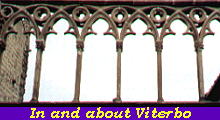 Bomarzo
Bomarzo